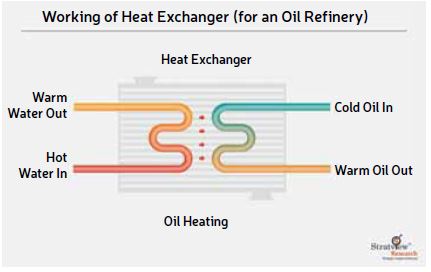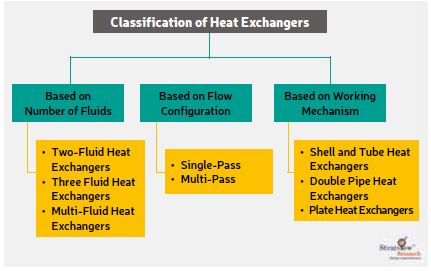While travelling down many roads, smoke rising from a smokestack can often be seen. The smoke that is visible is actually wasted energy that could be put to better use.
By Aditya Joshi – Head of Marketing, Stratview Research
By the means of combined heat and power (CHP), also called co-generation, heat escaping from smokestacks can be turned into electricity, and passed to grids to be used for a variety of commercial, non-commercial, or industrial purposes.
More than 70% of U.S. greenhouse gas emissions come from burning fossil fuels for electricity, heat, and transportation, U.S. Energy Information Administration (EIA) stated. CHP’s potential is remarkable, as it can help replace nearly 30% of power generated by burning fossil fuels, reduce CO₂ emissions by 20%, and can also save billions of expenditures, according to the experts.
How do CHPs work? Heat exchangers, here, play a vital role. Gasses exiting from the exhaust are passed through the heat exchanger’s central tube and cold water is circulated around the outer shell, travelling over and around the tube core, the exhaust gases are cooled and much of the heat in the gases is transferred to the water circuit to convert it into energy.
Heat exchangers are one of the common yet vital elements of power, utility, and technological installations. They are used in almost all industries such as oil & gas, petrochemicals & chemicals, pharmaceuticals, and more.

of liquid fuels.
For example, in a food and beverage processing plant, heat exchangers are used to reduce and eliminate microbials to prevent spoilage and make items safe and healthy for consumption. In oil & gas industries, almost all processes have heating, cooling, or condensation process that require heat exchangers. Heat Exchangers are also used in chemical and pharmaceutical industries for purposes including heating or cooling a solution, manufacturing pharmaceuticals, and to produce steam.
Petrochemical & chemical industries generate the nearly one-fourth of the demand for heat exchangers globally. Global liquid fuels production is estimated to increase by 1.1 million barrels per day in 2023 (refer to Figure 1).
How heat exchangers work
Heat exchangers, regardless of their type and design, exchange heat using the principles of thermal heat conduction, namely Zeroth, First, and Second laws of thermodynamics. These laws describe and dictate the transference of heat from one fluid to other. Assume a situation where one needs to heat a container full of oil, but putting it directly over the flame can be hazardous. To solve this, a heat exchanger can be used. Figure 2 depicts the working of a heat exchanger in this case.
If water is boiled and run using a metal rod or pipe through a simple heat exchanger, the oil will safely absorb the heat of water through the rod of the heat exchanger. The same process applies to other heat exchangers that are used in different machineries for thermal energy exchange. Despite the fact that all heat exchangers serve the same function, there are many different types with different applications. Classification of Heat Exchangers Based on their Design Characteristics The main attributes by which heat exchangers can be categorized are:
1. Based on the number of fluids The heat exchanger may incorporate two, three, or more than three heat transfer fluids in the system.
1.1 Be it heating, cooling, heat recovery, or heat rejection, every process involves transfer of heat between two fluids. Hence, two -fluid heat exchangers are the common ones.
1.2 Three-fluid heat exchangers are widely used in chemical processes such as air separation systems, a helium–air separation unit, purification and liquefaction of hydrogen.
1.3 Heat exchangers with multifluid streams are used in some of the chemical process applications. The design theory of these type of heat exchangers is said to be very complex.
2. According to Flow Configuration – The heat exchanger can be single or multiple pass. It can include crossflow, counterflow, or co-current flow. Heat exchangers often use a combination of these flow patterns to maximise thermal efficiency.
2.1 In single pass heat exchangers, the fluid goes in one end of each tube and out from the other once in the system.
2.2 Fluids in multi-pass heat exchangers are those which allow fluids to pass through the heat exchangers multiple times before exiting. This flow produces a thermally longer heat exchanger while preserving the same smaller footprint.
-
-
-
- Fluids flow in opposite directions towards each other in counter flow heat exchangers.
- Fluids flow perpendicular to each other in cross flow heat exchangers.
- Fluids flow parallel to each other in co-current flow heat exchangers.
-
-
3. Types of heat exchangers depending on their working mechanism. There are various heat exchanger versions available based on the features mentioned. Some of the popular variations used in industry by working mechanism include:
3.1 Shell and tube heat exchangers
3.2 Double pipe heat exchangers
3.3 Plate heat exchangers
Plate exchanger is the most efficient heat exchanger type, due to turbulent flow on both sides. High heat-transfer coefficient and high turbulence due to even flow distribution are always kept in mind by the business owners while deciding on the best heat exchanger. These heat exchangers can also increase their cooling capacity, unlike other types.




Increasing role of heat exchangers with rising emissions
With rising CO₂ emissions, the demand for heat exchangers is also shooting up. Global fossil CO₂ emissions were 5.1% higher in 2021 than in 2020, and Earth System Science Data (ESSD) stated that global fossil CO₂ emissions were expected to rise by 1.0% in 2022 to reach 10.0 GtC (36.6 GtCO₂). If current demography, emission-intensity continues, it is expected that there could be >60 GT carbon by 2030. 
To recover and achieve the target of net zero by 2050, the emissions rate must reduce at a faster pace. Heavy investments in development of green technologies in countries like China, India, and Japan, and more, depict the rising awareness in the sustainability formula.
Heat exchangers play a vital role in reducing CO₂ emissions. They are counted as green energy, as they use less energy, can also provide energy, and generate no pollution. To improve the efficiency, the need of compact heat exchangers is growing rapidly, as they reduce footprint as well as CO₂ emissions.
Increased focus on efficient thermal management across all industries, and meeting growing energy demand, are some more major factors that push the demand for heat exchangers. The market of global heat exchangers is estimated to grow at a healthy annual growth rate of more than 5% to cross USD $18 Billion by 2027.
Though the rising prices of raw materials like stainless steel and aluminium is a big challenge that the heat exchanger industry has witnessed, with the rising demand for energy efficiency and growing industrialization, the role of heat exchanger will only increase. At the same time, continuous developments and innovations in the segment will make machineries more environmentally friendly.

About the authors
 Aditya Joshi is a seasoned market research professional with 12 years of experience in consulting and custom research projects. He has authored various white papers and contributes regularly to various technology magazines and portals. He finds his interest in writing about innovations or trends in the heat & refrigeration industry and their applications across other major industries like oil & gas, petrochemical & chemical, power generation, Hvac & refrigeration, water & wastewater, and more.
Aditya Joshi is a seasoned market research professional with 12 years of experience in consulting and custom research projects. He has authored various white papers and contributes regularly to various technology magazines and portals. He finds his interest in writing about innovations or trends in the heat & refrigeration industry and their applications across other major industries like oil & gas, petrochemical & chemical, power generation, Hvac & refrigeration, water & wastewater, and more.

